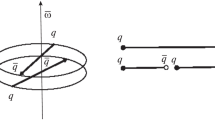Abstract.
Multihadron production in high energy collisions, from e+e- annihilation to heavy ion interactions, shows remarkable thermal behaviour, specified by a universal “Hagedorn” temperature. We argue that this hadronic radiation is formed by tunneling through the event horizon of colour confinement, i.e., that it is the QCD counterpart of Hawking-Unruh radiation from black holes. It is shown to be emitted at a universal temperature TH ≃ (σ/2 π)1/2, where σ denotes the string tension. Since the event horizon does not allow information transfer, the radiation is thermal “at birth”.
Similar content being viewed by others
References
P. Castorina, D. Kharzeev, H. Satz, Europ. Phys. J. C 52, 187 (2007) 187
E. Recami, P. Castorina, Lett. Nuovo Cim. 15, 347 (1976)
A. Salam, J. Strathdee, Phys. Rev. D 18 (1978)
A.F. Grillo, Y. Srivastava, Phys. Lett. B 85, 377 (1979)
S.W. Hawking, Comm. Math. Phys. 43, 199 (1975)
R. Hagedorn, Nuovo Cim. Suppl. 3, 147 (1965); Nuovo Cim. A 56, 1027 (1968)
F. Becattini, Z. Phys. C 69, 485 (1996) (e+e-); F. Becattini, U. Heinz, Z. Phys. C 76, 268 (1997) (\(pp/p\bar p\)); J. Cleymans, H. Satz, Z. Phys. C 57, 135 (1993) (heavy ions); F. Becattini et al., Phys. Rev. C 64, 024901 (2001) (heavy ions); P. Braun-Munziger, K. Redlich, J. Stachel, in Quark-Gluon Plasma 3, edited by R.C. Hwa, X.-N. Wang (World Scientific, Singapore, 2003) (heavy ions)
See e.g., Li Zhi Fang, R. Ruffini, Basic Concepts in Relativistic Astrophysics (World Scientific, Singapore, 1983)
W.G. Unruh, Phys. Rev. D 14, 870 (1976)
For a clear discussion and references to the original solutions by M. Born (1909) and A. Sommerfeld (1910), edited by W. Pauli, Relativitätstheorie, in Enzyklopädie der mathematischen Wissenschaften (Teubner-Verlag, Leipzig, 1921); English version Theory of Relativity (Pergamon Press, 1958)
T.D. Lee, Nucl. Phys. B 264, 437 (1986)
M.K. Parikh, F. Wilczek, Phys. Rev. Lett. 85, 5042 (2000)
M. Novello et al., Phys. Rev. D 61, 045001 (2000)
S. Barshay, W. Troost, Phys. Lett. 73B, 437 (1978)
A. Hosoya, Progr. Theoret. Phys. 61, 280 (1979)
M. Horibe, Progr. Theoret. Phys. 61, 661 (1979)
J. Schwinger, Phys. Rev. 82, 664 (1951)
J.D. Bjorken, Lect. Notes Phys. (Springer) 56, 93 (1976)
A. Casher, H. Neuberger, S. Nussinov, Phys. Rev. D 20, 179 (1979)
M. Lüscher, G. Münster, P. Weisz, Nucl. Phys. B 180, 1 (1981)
D. Kharzeev, K. Tuchin, Nucl. Phys. A 753, 316 (2005); D. Kharzeev [hep-ph/0511354]
D. Kharzeev, E. Levin, K. Tuchin [hep-ph/0602063]
J. Dias de Deus, C. Pajares [hep-ph/0605148]
R. Hagedorn, Thermodynamics of Strong Interactions, CERN 71-12 (1971); R. Stock, Phys. Lett. B 456, 277 (1999)
Author information
Authors and Affiliations
Rights and permissions
About this article
Cite this article
Satz, H. The origin of thermal hadron production. Eur. Phys. J. Spec. Top. 155, 167–175 (2008). https://doi.org/10.1140/epjst/e2008-00599-8
Issue Date:
DOI: https://doi.org/10.1140/epjst/e2008-00599-8




